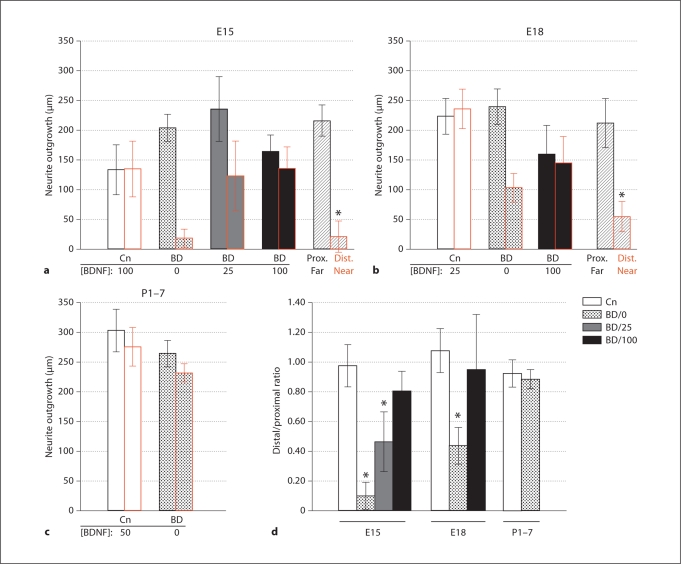Fig. 4.
Quantitation of neurite outgrowth in bead/ganglion cocultures. Proximal outgrowth (toward the bead) after 2 days in vitro is indicated by the left bar of each pair, distal outgrowth is indicated by the right bar. Error bars represent twice the SEM. a E15 geniculate ganglia. Outgrowth is not biased by control beads (Cn; white bars), but is strongly biased by BDNF beads (BD; dotted bars). Bias caused by BDNF beads is significant, even in the presence of 25 ng/ml BDNF in the bath (grey bars), but not in the presence of 100 ng/ml BDNF (black bars) (see d). In ‘2-ganglion’ assays in which ganglia were positioned at different distances from the bead (see Results), the proximal outgrowth from the distant ganglion (‘Prox. Far’) is significantly longer (p < 0.05, paired-values t test, 2-tailed) than the distal outgrowth from the closer ganglion (‘Dist. Near’). b E18 geniculate ganglia. Control beads do not bias outgrowth (white bars), but BDNF beads do (dotted bars). No bias is detected if 100 ng/ml BDNF is added to the bath (black bars). Outgrowth toward the beads from a distantly positioned ganglion (“Prox. Far”) is significantly longer than outgrowth away from the bead by a ganglion positioned near the bead (“Dist. Near”). c Infant geniculate ganglia (P17). No significant bias in neurite outgrowth was observed with control beads + 50 ng/ml BDNF in the bath, or with BDNF beads. d The ratio of the distal neurite growth to proximal neurite growth was calculated for most conditions. ANOVA was conducted to determine whether bead treatments differed significantly from one another. Asterisks mark treatments that differed significantly from the corresponding control treatments (p < 0.05), but additional significant differences are mentioned in Results. Bar legend: White bars correspond to distal:proximal outgrowth ratios using control beads and the bath concentration of BDNF indicated in ac for each stage. All other bars correspond to BDNF beads using the bath concentration (ng/ml) of BDNF indicated by the number following the ‘BD’. Numbers: a control bead, 10; BDNF bead, 19; BDNF bead + 25 ng/ml BDNF, 12; BDNF bead + 100 ng/ml BDNF, 12; 2-ganglion assay, 9 pairs. b Control bead, 14; BDNF bead, 35; BDNF bead + 100 ng/ml BDNF, 9; 2-ganglion assay, 11 pairs. c Control bead + BDNF bath, 18; BDNF bead, 21.

